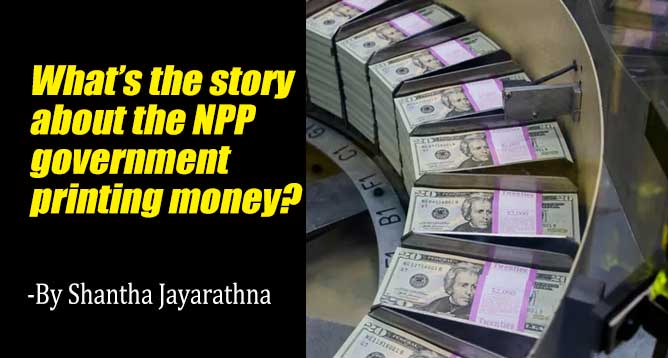-By Shantha Jayaratne

(Lanka-e-News -30.Oct.2024, 9.30 pm) Upon seeing this, I was reminded of the story of the “Daddabha Jataka.” While I can’t tell the full story, you may remember the hare who ran in fear, shouting that the earth was shaking after a fruit fell on his head. Similarly, certain opposition members and their social media activists are now running with the idea that the current government is printing money, after seeing information and images in an article originally published by an online site. They have found something to stir up for a few days, claiming loudly that “the government is printing money,” amplifying it beyond proportion, just like the hare’s imagined quake.
The claim that the Central Bank is printing money is not new. Controlling the country’s money supply is a core responsibility of the Central Bank. According to Article 31 of the Central Bank Act No. 16 of 2023, the Central Bank has this authority. The Central Bank conducts Open Market Operations (OMO) to either supply liquidity to or absorb liquidity from the money market. OMOs are the main tool the Central Bank uses to manage the money market. “Liquidity” refers to both the cash held by a financial institution and assets that can quickly be converted into cash.
The Central Bank issues weekly or bi-weekly notifications for the sale of Treasury Bills. Today (29th), the Central Bank of Sri Lanka announced the issuance of Treasury Bills worth Rs. 145 billion. These are divided into Rs. 55 billion with a 91-day maturity, Rs. 55 billion with a 182-day maturity, and Rs. 35 billion with a 364-day maturity, with the expectation that this amount will be raised from registered primary buyers.
The funds raised will be used to cover maturing bills and bonds issued by the previous government in October-November of the last year, and to meet other government expenses. In doing so, the Central Bank essentially absorbs liquidity from the money market (the banking system). Under Article 31 (1) (a) of the Act, the Central Bank’s Monetary Policy Board can provide necessary funds to the banking system to manage inflation and maintain financial stability if needed.
For instance, during the Gotabaya administration, the Central Bank released Rs. 1.2 trillion in 2021 and an additional Rs. 588 billion in the first quarter of 2022 to the money market, primarily due to the Modern Monetary Theory (MMT) approach. However, the recent activity is not similar to that. On October 25, the Central Bank added a little over Rs. 100 billion to the money market. Additionally, on the same date, commercial banks deposited Rs. 193.4 billion in excess funds through the Standing Deposit Facility (SDF).
With September 2024’s general inflation in Sri Lanka falling to 0.5%, a deflationary condition has arisen, similar to 2015. Food inflation, which was at 0.8% in August, dropped to 0.3% in September. Continuous economic contraction is not ideal, as it indicates minimal demand for goods and services. Therefore, the Central Bank’s recent liquidity injection may encourage private credit growth, boosting private investment and increasing the production sector’s capacity. More disposable income for citizens could drive demand for goods and services, encouraging supply growth to meet this demand.
An economic downturn may arise with reduced demand, leading to potential closures of small and medium industries, job losses, and decreased imports. The government must collaborate with the Central Bank to implement appropriate policies to mitigate this. Article 26 (1) of the new Central Bank Act binds the Central Bank to maintain the inflation rate specified by the Minister of Finance. For 2024, the target inflation rate is set at 5%.
However, the current deflationary condition is not favorable for the economy, so the Central Bank’s recent measures may be seen as an effort to steer the economy back on track.
---------------------------
by (2024-10-30 16:10:43)
Leave a Reply